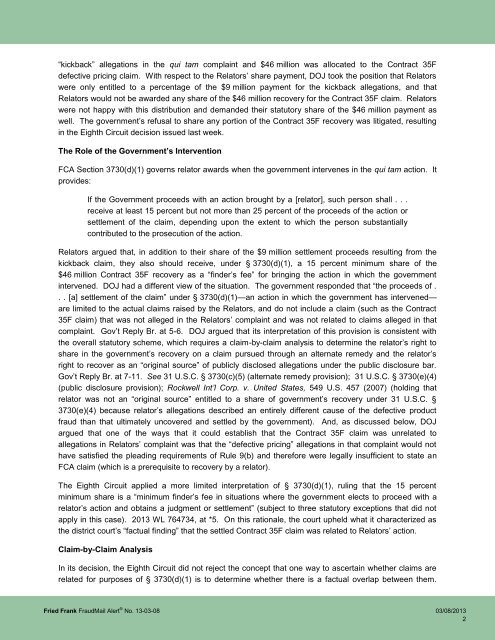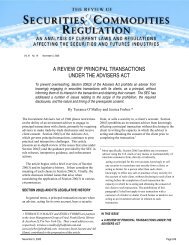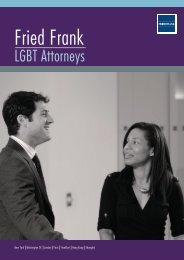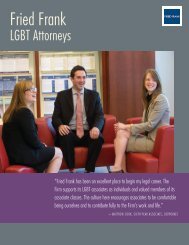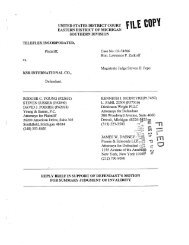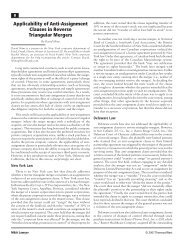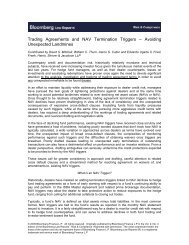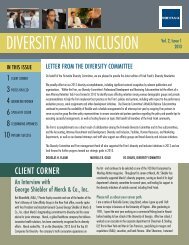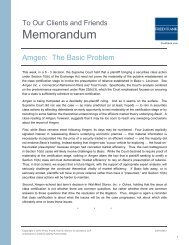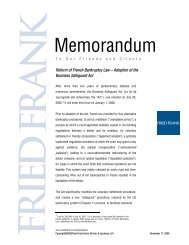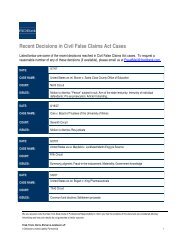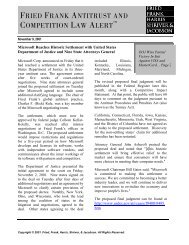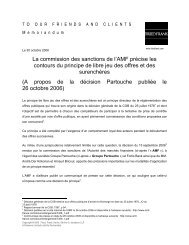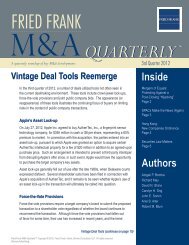CIVIL FALSE CLAIMS ACT: Eighth Circuit Rejects ... - Fried Frank
CIVIL FALSE CLAIMS ACT: Eighth Circuit Rejects ... - Fried Frank
CIVIL FALSE CLAIMS ACT: Eighth Circuit Rejects ... - Fried Frank
Create successful ePaper yourself
Turn your PDF publications into a flip-book with our unique Google optimized e-Paper software.
“kickback” allegations in the qui tam complaint and $46 million was allocated to the Contract 35F<br />
defective pricing claim. With respect to the Relators’ share payment, DOJ took the position that Relators<br />
were only entitled to a percentage of the $9 million payment for the kickback allegations, and that<br />
Relators would not be awarded any share of the $46 million recovery for the Contract 35F claim. Relators<br />
were not happy with this distribution and demanded their statutory share of the $46 million payment as<br />
well. The government’s refusal to share any portion of the Contract 35F recovery was litigated, resulting<br />
in the <strong>Eighth</strong> <strong>Circuit</strong> decision issued last week.<br />
The Role of the Government’s Intervention<br />
FCA Section 3730(d)(1) governs relator awards when the government intervenes in the qui tam action. It<br />
provides:<br />
If the Government proceeds with an action brought by a [relator], such person shall . . .<br />
receive at least 15 percent but not more than 25 percent of the proceeds of the action or<br />
settlement of the claim, depending upon the extent to which the person substantially<br />
contributed to the prosecution of the action.<br />
Relators argued that, in addition to their share of the $9 million settlement proceeds resulting from the<br />
kickback claim, they also should receive, under § 3730(d)(1), a 15 percent minimum share of the<br />
$46 million Contract 35F recovery as a “finder’s fee” for bringing the action in which the government<br />
intervened. DOJ had a different view of the situation. The government responded that “the proceeds of .<br />
. . [a] settlement of the claim” under § 3730(d)(1)—an action in which the government has intervened—<br />
are limited to the actual claims raised by the Relators, and do not include a claim (such as the Contract<br />
35F claim) that was not alleged in the Relators’ complaint and was not related to claims alleged in that<br />
complaint. Gov’t Reply Br. at 5-6. DOJ argued that its interpretation of this provision is consistent with<br />
the overall statutory scheme, which requires a claim-by-claim analysis to determine the relator’s right to<br />
share in the government’s recovery on a claim pursued through an alternate remedy and the relator’s<br />
right to recover as an “original source” of publicly disclosed allegations under the public disclosure bar.<br />
Gov’t Reply Br. at 7-11. See 31 U.S.C. § 3730(c)(5) (alternate remedy provision); 31 U.S.C. § 3730(e)(4)<br />
(public disclosure provision); Rockwell Int’l Corp. v. United States, 549 U.S. 457 (2007) (holding that<br />
relator was not an “original source” entitled to a share of government’s recovery under 31 U.S.C. §<br />
3730(e)(4) because relator’s allegations described an entirely different cause of the defective product<br />
fraud than that ultimately uncovered and settled by the government). And, as discussed below, DOJ<br />
argued that one of the ways that it could establish that the Contract 35F claim was unrelated to<br />
allegations in Relators’ complaint was that the “defective pricing” allegations in that complaint would not<br />
have satisfied the pleading requirements of Rule 9(b) and therefore were legally insufficient to state an<br />
FCA claim (which is a prerequisite to recovery by a relator).<br />
The <strong>Eighth</strong> <strong>Circuit</strong> applied a more limited interpretation of § 3730(d)(1), ruling that the 15 percent<br />
minimum share is a “minimum finder’s fee in situations where the government elects to proceed with a<br />
relator’s action and obtains a judgment or settlement” (subject to three statutory exceptions that did not<br />
apply in this case). 2013 WL 764734, at *5. On this rationale, the court upheld what it characterized as<br />
the district court’s “factual finding” that the settled Contract 35F claim was related to Relators’ action.<br />
Claim-by-Claim Analysis<br />
In its decision, the <strong>Eighth</strong> <strong>Circuit</strong> did not reject the concept that one way to ascertain whether claims are<br />
related for purposes of § 3730(d)(1) is to determine whether there is a factual overlap between them.<br />
<strong>Fried</strong> <strong>Frank</strong> FraudMail Alert ® No. 13-03-08 03/08/2013<br />
2


